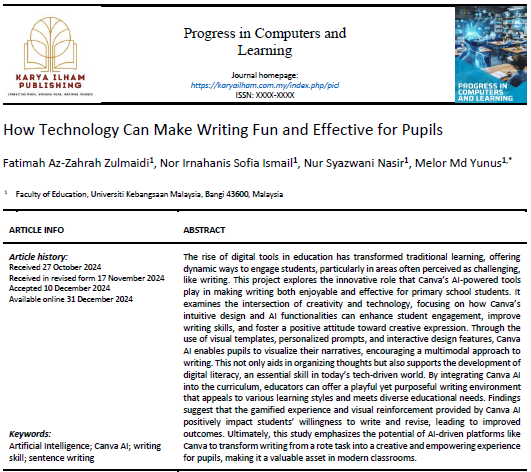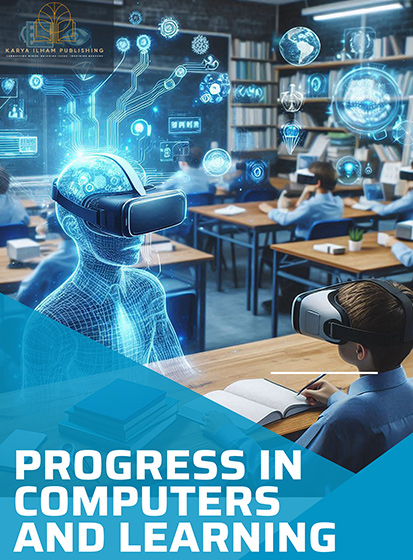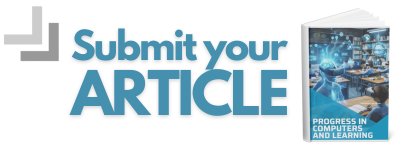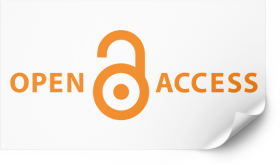How Technology Can Make Writing Fun and Effective for Pupils
DOI:
https://doi.org/10.37934/picl.1.1.4760Keywords:
Artificial intelligence, canva AI, writing skill, sentence writingAbstract
The rise of digital tools in education has transformed traditional learning, offering dynamic ways to engage students, particularly in areas often perceived as challenging, like writing. This project explores the innovative role that Canva’s AI-powered tools play in making writing both enjoyable and effective for primary school students. It examines the intersection of creativity and technology, focusing on how Canva’s intuitive design and AI functionalities can enhance student engagement, improve writing skills, and foster a positive attitude toward creative expression. Through the use of visual templates, personalized prompts, and interactive design features, Canva AI enables pupils to visualize their narratives, encouraging a multimodal approach to writing. This not only aids in organizing thoughts but also supports the development of digital literacy, an essential skill in today’s tech-driven world. By integrating Canva AI into the curriculum, educators can offer a playful yet purposeful writing environment that appeals to various learning styles and meets diverse educational needs. Findings suggest that the gamified experience and visual reinforcement provided by Canva AI positively impact students’ willingness to write and revise, leading to improved outcomes. Ultimately, this study emphasizes the potential of AI-driven platforms like Canva to transform writing from a rote task into a creative and empowering experience for pupils, making it a valuable asset in modern classrooms.
Downloads
References
[1] Aldalalah, Osamah Mohammad Ameen. "The Effectiveness of Infographic via Interactive Smart Board on Enhancing Creative Thinking: A Cognitive Load Perspective." International Journal of Instruction 14, no. 1 (2021): 345-364. https://doi.org/10.29333/iji.2021.14120a DOI: https://doi.org/10.29333/iji.2021.14120a
[2] Cecilia, K. Y. & Katherine, K. W. "Reflection literacy: A multilevel perspective on the challenges of using reflections in higher education through a comprehensive literature review." Educational Research Review 3, no. 2 (2020): 1-18.
[3] Lira-Gonzales, Maria-Lourdes, Kuok Wa Chao Chao, and Joanie David. "Technologies in English as a Second/Foreign Language Writing Classes." Folios 58 (2023): 171-187. https://doi.org/10.17227/folios.58-16435 DOI: https://doi.org/10.17227/folios.58-16435
[4] Churiyah, M., Basuki, A., Dharma, B. A., Filianti, F., & Sakdiyyah, D. A. (2022). Canva for Education as a Learning Tool for Center of Excellence Vocational School (SMK Pusat Keunggulan) Program to Prepare Competitive Graduates in the Field of Creative Skills in the Digital Age. In M. Churiyah, A. Basuki, B. A. Dharma, F. Filianti, & D. A. Sakdiyyah, International Journal of Community Service & Engagement (Vol. 3, Issue 1, p. 34). https://doi.org/10.47747/ijcse.v3i1.573 DOI: https://doi.org/10.47747/ijcse.v3i1.573
[5] Christopoulos, Athanasios, and Pieter Sprangers. "Integration of educational technology during the Covid-19 pandemic: An analysis of teacher and student receptions." Cogent Education 8, no. 1 (2021): 1964690. https://doi.org/10.1080/2331186X.2021.1964690 DOI: https://doi.org/10.1080/2331186X.2021.1964690
[6] Defi, Wahyu Fitrina, and Yudi Nanda Utama. "Integrating Instructional Leadership and Teaching Tools of AI in a Class; An Analysis for the Ethical Dimensions." In Proceeding International Conference on Religion, Science and Education, vol. 3, pp. 277-283. 2024.
[7] Hadi, Muhamad Sofian, Lidiyatul Izzah, and Qondila Paulia. "Teaching writing through Canva application." Journal of Languages and Language Teaching 9, no. 2 (2021): 228-235. https://doi.org/10.33394/jollt.v9i2.3533 DOI: https://doi.org/10.33394/jollt.v9i2.3533
[8] Hamzah, Fanidawarti, Abdul Hakim Abdullah, and Widad Ma. "Advancing Education through Technology Integration, Innovative Pedagogies and Emerging Trends: A Systematic Literature Review." Journal of Advanced Research in Applied Sciences and Engineering Technology 41, no. 1 (2024): 44-63. https://doi.org/10.37934/araset.41.1.4463 DOI: https://doi.org/10.37934/araset.41.1.4463
[9] Hehir, Elizabeth, Marc Zeller, Joanna Luckhurst, and Tara Chandler. "Developing student connectedness under remote learning using digital resources: A systematic review." Education and information technologies 26, no. 5 (2021): 6531-6548. https://doi.org/10.1007/s10639-021-10577-1 DOI: https://doi.org/10.1007/s10639-021-10577-1
[10] Hidayatullah, A., Artharina, F. P., Sumarno, S., & Rumiarci, E. (2023). Penggunaan Aplikasi Canva pada Pembelajaran di Sekolah Dasar. In A. Hidayatullah, F. P. Artharina, S. https://doi.org/10.31949/educatio.v9i2.4823
[11] Hidayatullah, Anisatun, Filia Prima Artharina, Sumarno Sumarno, and Endang Rumiarci. "Penggunaan Aplikasi Canva Pada Pembelajaran Di Sekolah Dasar". Jurnal Educatio FKIP UNMA 9, no. 2 (2023): 943-47. https://doi.org/10.31949/educatio.v9i2.4823 DOI: https://doi.org/10.31949/educatio.v9i2.4823
[12] Indriyani, Vivi, Hasri Fendi, and Rohaidah Binti Haron. "The Influence of Online Self-Regulated Learning on BIPA Teaching Material Development Skills Using the Canva Application." KEMBARA: Jurnal Keilmuan Bahasa, Sastra, dan Pengajarannya 10, no. 1 (2024): 147-160. https://doi.org/10.22219/kembara.v10i1.27812 DOI: https://doi.org/10.22219/kembara.v10i1.27812
[13] Folstad, A. & Brandtzaeg, P. B. "Users' Experiences with Chatbots: Findings from a Questionnaire Study." Quality and User Experience 5, no. 1 (2020): 1–14. https://doi.org/10.1007/s41233-020-00033-2 DOI: https://doi.org/10.1007/s41233-020-00033-2
[14] Fauziyah, Nabielah Luaily, J. Priyanto Widodo, and Shierly Novalita Yappi. "The use of ‘Canva for Education’ and the students’ perceptions of its effectiveness in the writing procedure text." Budapest International Research and Critics Institute-Journal (BIRCI-Journal) 5, no. 1 (2022). https://doi.org/10.33258/birci.v5i1.4359
[15] Fitria, Tira Nur. "Using Canva as media for English Language Teaching (ELT) in developing creativity for Informatics students." ELT Echo: The Journal of English Language Teaching in Foreign Language Context 7, no. 1 (2022): 58-68. https://doi.org/10.24235/eltecho.v7i1.10789 DOI: https://doi.org/10.24235/eltecho.v7i1.10789
[16] Khairani, Siti, Retno Dwi Suyanti, and Daulat Saragi. "The Influence of Problem Based Learning (PBL) Model Collaborative and Learning Motivation Based on Students’ Critical Thinking Ability Science Subjects in Class V State Elementary School 105390 Island Image." Budapest International Research and Critics in Linguistics and Education (BirLE) Journal 3, no. 3 (2020): 1581-1590. https://doi.org/10.33258/birle.v3i3.1247 DOI: https://doi.org/10.33258/birle.v3i3.1247
[17] Kerimbayev, N., Umirzakova, Z., Shadiev, R. et al. "A student-centered approach using modern technologies in distance learning: a systematic review of the literature." Smart Learn. Environ. 10, 61 (2023). https://doi.org/10.1186/s40561-023-00280-8 DOI: https://doi.org/10.1186/s40561-023-00280-8
[18] Larasati, Mustika. "Empowering student’s creative writing ability by using Canva." Journal of English Education Program (JEEP) 9, no. 2 (2022): 101-110. https://doi.org/10.25157/(jeep).v9i2.8548 DOI: https://doi.org/10.25157/(jeep).v9i2.8548
[19] Lin, YL., Wang, WT. "Enhancing students’ online collaborative PBL learning performance in the context of coauthoring-based technologies: A case of wiki technologies." Educ Inf Technol 29 (2024): 2303–2328. https://doi.org/10.1007/s10639-023-11907-1 DOI: https://doi.org/10.1007/s10639-023-11907-1
[20] Mabe, Alexis, Kelly Brown, J. Edward Frick, and Frederico Padovan. "Using Technology to Enhance Project-Based Learning in High School: A Phenomenological Study." Education Leadership Review of Doctoral Research 10 (2022): 1-14.
[21] Muniandy, Jayanthi, and Munir Shuib. "Learning styles, language learning strategies and fields of study among ESL learners." Malaysian Journal of ELT Research 12, no. 1 (2016).
[22] Mohammed, Yakubu Bala, and Fezile Ozdamli. "Motivational effects of gamification apps in education: a systematic literature review." BRAIN. Broad research in artificial intelligence and neuroscience 12, no. 2 (2021): 122-138. https://doi.org/10.18662/brain/12.2/196 DOI: https://doi.org/10.18662/brain/12.2/196
[23] Jamaludin, Nabila Farhana, and Siti Farahin Sedek. "CANVA as a Digital Tool for Effective Student Learning Experience." Journal of Advanced Research in Computing and Applications 33, no. 1 (2023): 22-33. https://doi.org/10.37934/arca.33.1.2233 DOI: https://doi.org/10.37934/arca.33.1.2233
[24] Nicolaou, Constantinos, Maria Matsiola, and George Kalliris. "Technology-enhanced learning and teaching methodologies through audiovisual media." Education Sciences 9, no. 3 (2019): 196. https://doi.org/10.3390/educsci9030196 DOI: https://doi.org/10.3390/educsci9030196
[25] Nur Fitria, Tira. (2021). Artificial Intelligence (AI) In Education: Using AI Tools for Teaching and Learning Process.
[26] Piaget, J. (1970). Science of education and the psychology of the child. Orion Press.
[27] Rumiantseva, Kateryna, Natalia Yevdokymova, Sergiy Bratushka, Nataliia Kharchenko, and Oleksandr Iievliev. "The importance of multimedia means usage in improving the quality of education." Cadernos de Educação Tecnologia e Sociedade 16, no. 3 (2023): 665-674. https://doi.org/10.14571/brajets.v16.n3.665-674 DOI: https://doi.org/10.14571/brajets.v16.n3.665-674
[28] Ravi, P., Broski, A., Stump, G., Abelson, H., Klopfer, E., & Breazeal, C. (2023). Understanding Teacher Perspectives and Experiences After Deployment of AI Literacy Curriculum in Middle-School Classrooms. In P. Ravi, A. Broski, G. Stump, H. Abelson, E. Klopfer, & C. Breazeal, ICERI proceedings (Vol. 1, p. 6875). International Academy of Technology, Education and Development. https://doi.org/10.21125/iceri.2023.1716 DOI: https://doi.org/10.21125/iceri.2023.1716
[29] Sankey, Michael, Dawn Birch, and Michael Gardiner. "The impact of multiple representations of content using multimedia on learning outcomes across learning styles and modal preferences." International Journal of Education and Development using ICT 7, no. 3 (2011): 18-35.
[30] Spatioti, A. G., Kazanidis, I., Pange, J. A. "Comparative Study of the ADDIE Instructional Design Model in Distance Education." Information 22, no. 13(2022): 1-22. https://doi.org/10.3390/info13090402 DOI: https://doi.org/10.3390/info13090402
[31] Widiastuti, Dina Eka. "The implementation of Canva as a digital learning tool in English learning at vocational school." English Learning Innovation (englie) 5, no. 2 (2024): 264-276. https://doi.org/10.22219/englie.v5i2.34839 DOI: https://doi.org/10.22219/englie.v5i2.34839
[32] Suryani, Nyayu Yayu, Syamsul Rizal, Tri Rohani, and Herin Ratnaningsih. "Improving Learners'english Writing Skills Through Digital Technology and Project-Based Learning." Jurnal Ilmiah Ilmu Terapan Universitas Jambi 8, no. 1 (2024): 21-34. https://doi.org/10.22437/jiituj.v8i1.32506 DOI: https://doi.org/10.22437/jiituj.v8i1.32506
[33] Syahdan, S., Herlinawati, H., Syaifullah, S., & Syafitri, D. T. "Challenges and strategies of teachers in integrating Canva in English classroom teaching." ELT-Lectura: Studies and Perspectives in English Language Teaching 10, no. 1 (2023): 12–20. https://doi.org/10.31849/elt-lectura.v10i1.1291 DOI: https://doi.org/10.31849/elt-lectura.v10i1.12115
[34] Veri Hardinansyah Dja’far, and Fitria Nur Hamidah. "The Effectiveness of AI Technology in Improving Academic English Writing Skills in Higher Education." Journal of Language and Literature Studies 4, no. 3 (2024): 579–593. https://doi.org/10.36312/jolls.v4i3.2031
[35] Widiarti, Yenni. "Canva and Comic Strips: Facilitate on Teaching Writing Instruction." International Journal of Contemporary Studies in Education (IJ-CSE) 3, no. 3 (2024): 245-255. https://doi.org/10.56855/ijcse.v3i3.1170 DOI: https://doi.org/10.56855/ijcse.v3i3.1170
[36] Vygotsky, L. S. (1978). Mind in society: The development of higher psychological processes. Harvard University Press.
[37] Yacob, Azliza, Zirawani Baharum, WM Amir Fazamin W. Hamzah, Aini Zuriyati, and Noor Suhana Sulaiman. "The World of Digital Education." International Journal of Synergy in Engineering and Technology 4, no. 1 (2023): 35-45.
[38] Wood, David, Jerome S. Bruner, and Gail Ross. "The role of tutoring in problem solving." Journal of child psychology and psychiatry 17, no. 2 (1976): 89-100. https://doi.org/10.1111/j.1469-7610.1976.tb00381.x DOI: https://doi.org/10.1111/j.1469-7610.1976.tb00381.x















